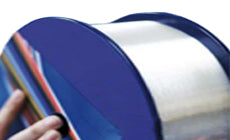
Draka’s TeraLightTM Non-Zero Dispersion Shifted Fiber (NZDSF) has set the standard for high bit-rate, multi-wavelength transmission. Its unique optimization of effective area, chromatic dispersion and dispersion slope enables excellent distorsion management cost effective operation at 10 and 40 Gbps, tight channel spacing in C- and L-bands, compatibility with the future Sband.
TeraLightTM Ultra is further optimized for long-haul and ultra-long-haul applications. Its typical chromatic dispersion of 8 ps/nm.km at 1550 nm is optimized to be half that of standard single-mode fiber resulting in lower costs for dispersion compensation, but high enough to counter cross-channel non-linearities. Guaranteed PMD link design value of 0.04 ps/??km keeps distorsions within tolerable limits, permitting 3 to 5 times longer distances without regeneration at 40 Gbps than fibers with higher PMD values, resulting in cost savings. Low attenuation in the 1450 nm region ensures maximum efficiency of distributed Raman amplification systems. Channel spacing as low as 25 GHz at 10 Gbps in C- and L-bands allows future capacity expansion. Commercially available dispersion compensation devices provide near 100% chromatic dispersion and dispersion slope compensation.
The fiber complies with or exceeds the ITU-T Recommendations G.655.E/G.656, the IEC International Standard 60793-2-50 type B4/B5 and can be used in all cable constructions, including loose tube, tight buffered, ribbon and central tube designs. Draka’s Advanced Plasma and Vapor Deposition (APVDTM) manufacturing process and proprietary ColorLock-XS coating process further enhance fiber purity, reliability, and durability.
Features:
• Optimized for 2.5 and 10 Gbps operation without dispersion
compensation in Metropolitan area networks
• 40 Gbps operation with commercially available dispersion
compensation devices
• Compatibility with long haul NZDSF
• More than 160 channels in C-band alone at 10 Gbps
• 320 channels in C-, L- and S-bands at 10 Gbps
• S-band compatibility
Advantages:
• Cost savings compared to standard single-mode fiber (DCU +
potentially EDFA)
• Simplifies network design and management
• Increase network flexibility
• Allows use of cheap transmitter
• Future safe investment
• Close to 100% dispersion slope compensation
• Contact Draka for availability
• Easy extension of route distances
• Consistent fiber type minimizes network complexity
• Maximizing C-band utilization defers costly L-band deployment,
providing significant cost savings
• Higher capacity and more efficient bandwidth use
• Future capacity increase
• Efficiently supports 1460 – 1625 nm 8 channels CWDM cheap
transmission systems
